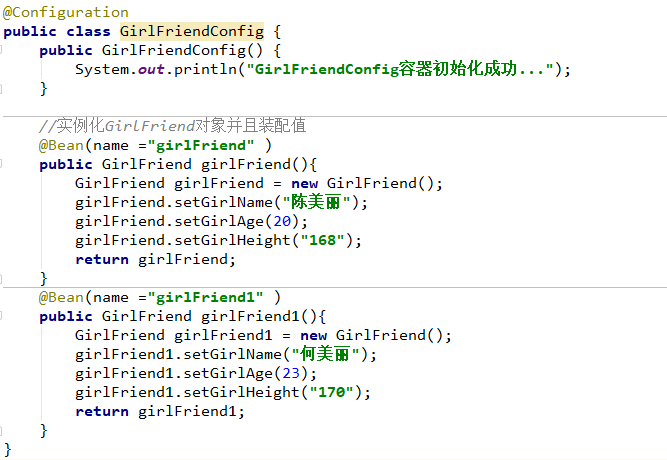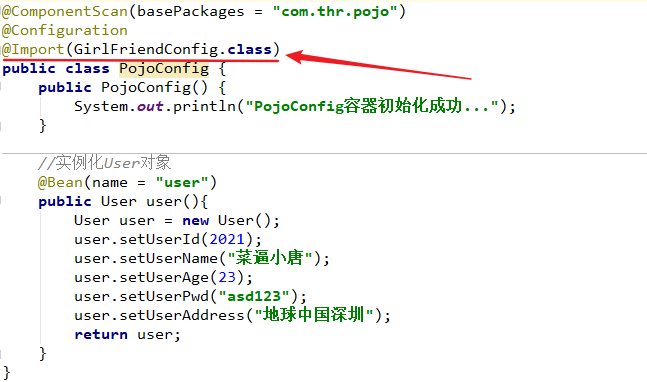1、@Configuration与@Bean的使用
@Configuration与@Bean主要用于在 Java 代码中实现 Spring 的配置,它的目的替换Spring的xml配置文件。@Configuration用于定义配置 Spring容器(应用上下文),被它修饰的类表示可以使用 Spring IoC 容器作为 bean 定义的来源,@Bean注解用于注册bean对象,被标记的方法的返回值会作为bean被加入到springIOC容器之中。如果要获取它们,我们可以使用AnnotationConfigApplicationContext 或 AnnotationConfigWebApplicationContext类进行扫描,并用于构建bean定义,初始化Spring容器。这两者的配合使用会在SpringBoot中大量使用,用来替代XML配置,因为SpringBoot不提倡使用XML配置文件开发。
下面我们来简单介绍一下这两个注解:
- @Configuration:标注在类上,作用为:配置Spring容器(应用上下文)。相当于把该类作为Spring的 xml 配置文件中的<beans>元素(并且包含命名空间)。
- @Bean:标注在方法上,作用:注册bean对象。相当于把该方法的返回值作为 xml 配置文件中<beans>的子标签<bean>,其中@Bean的配置项中包含 5个配置项:
value:等同于下面的name属性 name:相当于bean的id,<bean id="">,它是一个字符串数组,允许配置多个 BeanName,如果不配置,则默认是方法名 autowire:标志是否是一个引用的 Bean 对象,默认值是 Autowire.NO initMethod:自定义初始化方法 destroyMethod:自定义销毁方法
本节我们就来学习如何使用@Configuration与@Bean在Java代码中给容器之中添加Bean。下面简单举例:
①、首先创建一个User类,如下:
/**
* 用户实体类
*/
public class User {
private int userId;
private String userName;
private int userAge;
private String userPwd;
private String userAddress;
//这里使用注解自动配置
@Autowired(required = false)
private GirlFriend girlFriend;
//getter、setter、toString方法省略......
}②、创建一个GirlFriend类,如下:
/**
* GirlFriend实体
*/
public class GirlFriend {
private String girlName;
private int girlAge;
private String girlHeight;
//getter、setter、toString方法省略......
}③、创建PojoConfig类,用来启动容器和注册Bean对象:
package com.thr.pojo;
import org.springframework.context.annotation.Bean;
import org.springframework.context.annotation.ComponentScan;
import org.springframework.context.annotation.Configuration;
@ComponentScan(basePackages = "com.thr.pojo")
@Configuration
public class PojoConfig {
public PojoConfig() {
System.out.println("PojoConfig容器初始化成功...");
}
//实例化User对象并且装配值
@Bean(name = "user")
public User user(){
User user = new User();
user.setUserId(2021);
user.setUserName("菜逼小唐");
user.setUserAge(23);
user.setUserPwd("asd123");
user.setUserAddress("地球中国深圳");
return user;
}
//实例化GirlFriend对象并且装配值
@Bean(name ="girlFriend" )
public GirlFriend girlFriend(){
GirlFriend girlFriend = new GirlFriend();
girlFriend.setGirlName("陈美丽");
girlFriend.setGirlAge(20);
girlFriend.setGirlHeight("168");
return girlFriend;
}
@Bean(name ="girlFriend1" )
public GirlFriend girlFriend1(){
GirlFriend girlFriend1 = new GirlFriend();
girlFriend1.setGirlName("何美丽");
girlFriend1.setGirlAge(23);
girlFriend1.setGirlHeight("170");
return girlFriend1;
}
}
上面的PojoConfig.java代码相当于如下的xml配置:
<?xml version="1.0" encoding="UTF-8"?>
<beans xmlns="http://www.springframework.org/schema/beans"
xmlns:xsi="http://www.w3.org/2001/XMLSchema-instance"
xmlns:context="http://www.springframework.org/schema/context"
xsi:schemaLocation="http://www.springframework.org/schema/beans
http://www.springframework.org/schema/beans/spring-beans.xsd
http://www.springframework.org/schema/context
https://www.springframework.org/schema/context/spring-context.xsd">
<!--组件自动扫描,指定注解扫描包路径-->
<!-- base-package放的是包名,有多个包名中间用逗号隔开 -->
<context:component-scan base-package="com.thr.pojo"/>
<!--实例化GirlFriend-->
<bean id="girlFriend" class="com.thr.pojo.GirlFriend">
<property name="girlName" value="陈美丽"/>
<property name="girlAge" value="20"/>
<property name="girlHeight" value="168"/>
</bean>
<bean id="girlFriend1" class="com.thr.pojo.GirlFriend">
<property name="girlName" value="何美丽"/>
<property name="girlAge" value="23"/>
<property name="girlHeight" value="170"/>
</bean>
<!--实例化User-->
<bean id="user" class="com.thr.pojo.User">
<property name="userId" value="2021"/>
<property name="userName" value="菜逼小唐"/>
<property name="userAge" value="23"/>
<property name="userPwd" value="asd123"/>
<property name="userAddress" value="地球中国深圳"/>
<!--这里本来是要注入GirlFriend对象的,这里使用@Autowired注解 自动注入-->
<!--<property name="girlFriend" ref="girlFriend"/>-->
</bean>
</beans>④、测试代码(这里使用AnnotationConfigApplicationContext类来获取):
/**
* 测试代码
*/
public class SpringTest1 {
public static void main(String[] args) {
//1.初始化Spring容器,通过注解加载
ApplicationContext applicationContext = new AnnotationConfigApplicationContext(PojoConfig.class);
//2.通过容器获取实例
User user = applicationContext.getBean("user", User.class);
//3.调用实例中的属性
System.out.println(user.getUserId()+"----"+
user.getUserName()+"----"+
user.getUserAge()+"----"+
user.getGirlFriend());
}
}⑤、运行测试代码,查看控制台打印结果:

从上面的运行结果来看,bean对象已经创建成功了。
2、@import注解
@import 注解允许从另一个配置类中加载 @Bean 定义。例如将上面注册的GirlFriend对象拆分到一个GirlFriendConfig类中,然后通过@import注解在PojoConfig类中加载,如下所示:
---新建的GirlFriendConfig类:

---PojoConfig类:

运行结果如下图所示:

可以发现是先初始化主容器,然后再初始化了外部引入的配置类容器。